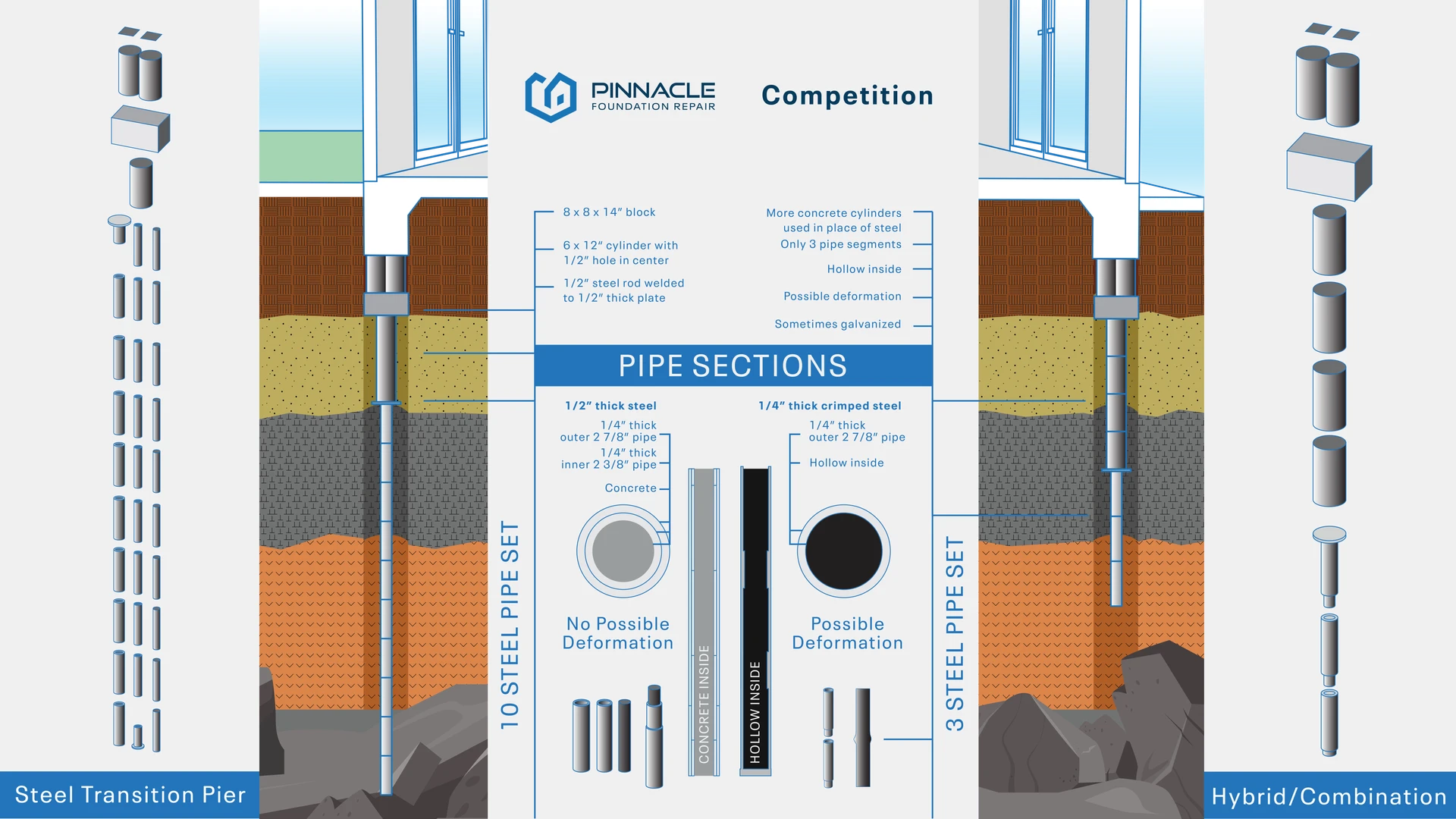Steel Transition Piers
Combining Durability with Cost-Effectiveness
LIFETIME WARRANTY
Contact Us
If you have any query about our service please contact with us
If you need lasting stability in your foundation repair without breaking the bank, steel transition piers offer a compelling solution. These piers represent a fusion of our steel and concrete technologies, designed to penetrate deep into the ground and provide exceptional support for structures. Similar to our steel pier system, steel transition piers offer superior durability when compared to concrete pressed pilings or drilled piers, ensuring long-term stability for your property.
The choice between different pier systems depends not only on the age and condition of the structure, but also on the soil type. Our steel transition piers excel in areas where soil conditions may vary or be unstable (like in our clay-heavy Texas soil), making them a versatile option for foundation repair projects, and one we highly recommend at Pinnacle Foundation Repair.
Introducing Steel Transition Piers: The Best of Both Worlds
When faced with the dilemma of choosing between steel and concrete pier systems, transition piers emerge as a versatile and cost-effective solution. Combining the strengths of both materials, transition piers harness the durability of steel and the affordability of concrete, delivering rock-solid stability at a reasonable cost. Simply put, it’s the best of both worlds without breaking the bank. Told you we were radically honest!
So, how does it work? Steel transition piers mix double-walled steel and high-strength concrete to provide a strong, stable foundation at a reasonable cost. Compared to a standard concrete pressed piling or a drilled pier, they reach deeper into the ground for greater stability. The steel transition system comprises 3” diameter double-walled steel sealed with cement, accompanied by friction reduction plates for deep penetration. Stacked atop are 8000 psi concrete cylinders, driving the steel to maximum depth and ensuring a strong and stable foundation.
Other foundation repair companies sometimes employ thinner, hollow steel tubes that may lose their shape over time. Not us – at Pinnacle, we take a radically different approach. Our steel tubes are robust, measuring 1/2 inch in thickness and filled with concrete. This ensures a permanent, stable, and non-deformable repair solution.
Pros and Cons of Steel Transition Piers for Foundation Repair
Pros:
Cost-Effective: Transition piers offer a reliable solution without breaking the bank, ensuring durability at an affordable price point.
Enhanced Depth: Combining steel and concrete allows transition pier systems to delve deeper than concrete alone, providing a more stable foundation. (Note – transition piers may not reach the same depth as our premium steel pier system, potentially affecting stability on bigger projects)
Steadfast Support: Interlocked segments ensure a robust structure that remains unaffected by upper-level soil movement, delivering long-lasting stability.
Versatility: Transition piers are highly adaptable to various soil types, making them an excellent choice for addressing foundation issues in diverse environments.
Cons:
Installation Complexity: The installation process of steel transition piers may be more complex compared to some other foundation repair methods, requiring specialized equipment and expertise.
Potential Disruption: While relatively non-invasive, the installation of steel transition piers may still cause some disruption to the property, particularly in areas with limited access. A lot of stress is required to push the segments into the ground, and this can cause stress to the structure.
Choosing Your Foundation Repair Solution
When choosing the best foundation repair solution for your home, if you are faced with choosing between a steel pier system, a concrete pier system, or our hybrid steel transition pier system, it is important to know what your budget is and what your long-term plan for the home is.
If you want to avoid any disturbance and cause minimal stress to the home, it’s possible that standard concrete piers are the method for you. However, if you plan to live in your home long-term and want to invest in its stability for decades to come, investing a little extra for either of our quality steel pier systems is a good idea. If your structure is facing settlement issues due to shifting soils, steel transition piers will provide the stability needed to safeguard your home.
Radically Honest and Transparent
Around here, we’re always on the level. We take the time to explain problems and possible solutions in plain language, walk you through the process, and answer all your questions before, during and after the project. To make communication even easier, your home evaluator is also your main point of contact throughout. Radically simple? You bet.
At Pinnacle Foundation Repair, we are committed to providing not just repairs, but lasting stability for your home or business. We also stand by our work with a radical commitment: A lifetime warranty on our steel transition pier system. And if you sell your home, it’s transferable to the new owner free of charge within 60 days of purchase.
Contact us today for a FREE consultation and discover why our steel transition pier system stands as a testament to our radical reliability and dependability in foundation repair.
Frequently Asked Questions
What are steel transition piers, and how are they different from other pier systems?
Steel transition piers are a hybrid of steel and concrete piers, giving you deep penetration and extra stability at a more affordable price than all-steel piers.
How do steel transition piers bring together the best of steel and concrete?
They use the strength of steel for deep penetration and the cost-effectiveness of concrete for surface stability, offering a balanced approach to foundation repair.
In what situations are steel transition piers the best choice for foundation repair?
Steel transition piers are great for homes in areas with varying or unstable soils, providing a versatile and cost-effective solution for long-term stability.
What’s the installation process like for steel transition piers?
We drive double-walled steel tubes filled with concrete deep into the ground, then stack high-strength concrete cylinders on top for extra support.
How do steel transition piers perform in different soils, especially in Texas?
They perform exceptionally well in Texas’ clay-heavy soil, providing stability in areas where soil conditions tend to shift.
What are the cost benefits of using steel transition piers?
Steel transition piers are more budget-friendly than all-steel piers but still offer more depth and stability than just concrete piers.
Are steel transition piers backed by a warranty?
Yes! Our steel transition piers come with a lifetime warranty, giving you peace of mind and lasting protection for your home’s foundation.
What kind of disruptions might happen during the installation of steel transition piers?
There might be some minor disruptions due to the force needed to drive the piers into the ground, but we work to keep any impact on your property to a minimum.
How can I get a quote or more details about Pinnacle’s steel transition piers?
Contact us today for a free foundation inspection! Our team will assess your home’s needs and provide a detailed quote. Call us at 972-251-0018 or fill out our online form to schedule your free inspection.

Schedule a FREE foundation evaluation
Don t wait till the cracks in the walls or the sticking doors become worse. Let us inspect your foundation free of charge, determine the cause of your problems and, if you have a foundation issue, give you a fair estimate. 1 out of 3 evaluations we conduct reveal no foundation issues
or call this number

